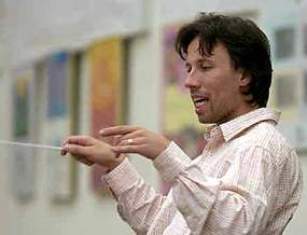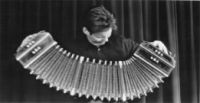Kristjan Järvi Shakes Music Hall
Mary Ellyn Hutton
Posted: Oct 3, 2009 - 1:56:46 AM in
reviews_2009

Kristjan Järvi
(photo by Bruce Crippen)
|
There was a seismic event at Music Hall Friday (October 2).
And once again, it's name was Järvi.
This time it was Kristjan Järvi, younger brother of Cincinnati Symphony music director Paavo Järvi, in his CSO subscription debut.
It was not the first time the younger Järvi has conducted in Cincinnati. He was in the pit for Cincinnati Opera's "Nixon in China" in July, 2007, and he came back in December of that year to lead the CSO's New Year's Eve concert at Music Hall. Both gave notice that there was another Järvi maestro in the wings.
Few in the audience could have anticipated, however, the tectonic shift that took place in venerable Music Hall when he took his place on the podium Friday night. It didn't hurt that he brought a dynamite program with him, all Latin American, and also a compelling soloist, bandeonist Carel Kraayenhof.
None of the music had been heard on CSO concerts before (most likely, this was the chief reason the audience was smaller than it should have been).
Heard were Four Dances from Argentine composer Alberto Ginastera's "gaucho" ballet "Estancia" (estancia means ranch, gaucho is the Argentine cowboy), the Concerto for Bandoneon, "Aconcagua" by Ginastera's countryman Astor Piazzolla, and Mexican composer Silvestre Revueltas' "La Noche de los Mayas" ("The Night of the Mayas").
Soloist in Piazzolla's Concerto was Kraayenhof, a bandeonista for the world, who played the instrument with matchless skill and affection.
Järvi, 37, is is an extraordinarily energetic conductor with charisma to burn. The joy he brings to making music is obvious and communicates itself readily to his players and to the audience. In this respect as well as in physical appearance, he resembles his father, Estonian conductor Neeme Järvi, whose love for music and delight in sharing it with others are legendary.
It was a further testament to Kristjan Järvi's skill that he led the entire program from memory.
Clad in a long velvet jacket, he seemed like a panther at times, ready to devour his players with expressive intent (and usually a warm smile as well).
There were moments in "Estancia," a Copland-esque work whose music put Ginastera on the map, where Järvi virtually mirrored the music. He led the "Wheat Dance" with dancing motions and threw cues like a lasso in "The Cattlemen." In the concluding "Malambo," a gaucho dance of dizzying velocity and rhythmic force, he spurred them on mercilessly, drawing an ovation to match from the audience.

Carel Kraayenhof playing the bandoneon
|
Dutchman Kraayenhof, a philosophy major in college, took up the bandoneon after an earlier interest in Irish concertina music. A stranger who heard him play told him he should try the bandoneon and obligingly supplied him with one. After spending time in Argentina learning the language and the instrument, Kraayenhof came to the attention of Piazzolla who helped give him his start. He gained further visibility -- an estimated 55 million television viewers -- when he performed for the wedding of Crown Prince Willem-Alexander and Princess Maxima of the Netherlands in 2002.
The bandoneon is a German instrument brought to Argentina by European immigrants in the 19th century. It is a squeezebox similar to the accordion, but smaller and played entirely with buttons. It has a soulful sound exquisitely suited to the tango, with which it became closely associated (Piazzolla himself was a bandoneonist). Kraayenhof held it across his thigh with his right leg placed on a chair.
Scored for strings, harp, piano and percussion, Piazzolla's 1979 Concerto started propulsively, as if in the middle of things, with the bandoneon sounding very improvisatory. What a variety of timbres Kraayenhof produced and how masterfully he carved the sound by varying in the way he opened and closed the instrument, from soft and dreamy to percussive. ("Aconcagua," by the way is the name of a mountain in the Argentine Andes, the highest peak in the Americas and outside Asia.)
The slow movement (Moderato), a romantic effusion, was lush and warm and featured a lovely trio episode with concertmaster Timothy Lees, harpist Gillian Benet Sella and principal cellist Ilya Finkelshteyn. Kraayenhof brought the movement to a soft, soulful end with a gentle shake of the instrument. The Presto finale was filled with infectious rhythms. Järvi tossed his hand gleefully over his shoulder to signal some catchy violin glissandi at one point.
Response to the performance was instantaneously enthusiastic, prompting a pair of encores combined into one, an affecting, melancholy tango by Kraayenhof and Piazzolla's best known work (which made Princess Maxima cry) "Adios Nonino," written in response to the death of his father.
The concert's bombshell was dropped after intermission with Revueltas' "La Noche de Los Mayas," a four-movement suite derived from the score for a 1939 film. It's all about the Mayas, the glorious but mysteriously extinguished meso-american civilization that fascinates to this day. Bass drum reports (Mark Wolfley) and a fanfare-like opening conjured Copland's"Fanfare for the Common Man" briefly before turning darkly serious. The mood was broken by a gentle contrasting section for violin, violas and winds before returning from whence it came.
The frolicsome "Noche de Jaranas," a happy scherzo movement that sounded like a little training chugging, saw Järvi hopping on one foot briefly and casting a mischievous glance at the audience at as the tuba added a final punctuation mark.
"Noche de Yucatan" (Andante espressivo) was lush and filled with cello coloration. After a winsome duet for clarinets, sweet exchanges by the violins and horns and a march-like moment for flute and side drum, snap pizzicatos in the double basses announced a climatic shift. It was percussion heaven from then on, as the music exploded into a huge, variations movement.
No less than eight percussionists in addition to timpanist Patrick Schleker -- William Platt, David Fishlock and Richard Jensen of the CSO, joined by Mark Wolfley, Michael LaMattina, Jeff Lutt, Fred Thiergartner and Scott Lang -- wielded everything from xylophones, drums and shakers to guiro and tam-tam for an orgy of color, poly-rhythms and improvisation that brought the house down. Trumpeter Doug Lindsay laid down his trumpet for a conch shell (fitted with a trumpet mouthpiece).
There was a run up to the end as in Stravinsky's "Rite of Spring," with a return of the opening fanfare-like music, squealing clarinets and French horns, bells up.
Järvi had his encore prepared (just like his father Neeme), a repeat of the "Malambo" from "Estancia." The crowd roared its approval again, with a prolonged standing ovation.
Repeat (be there) is 8 p.m. tonight at Music Hall. Call (513) 381-3300 for tickets (and don't miss the opening "Classical Conversation" with Carel Kraayenhof and CSO assistant conduct Vincent Lee at 7 p.m.).


